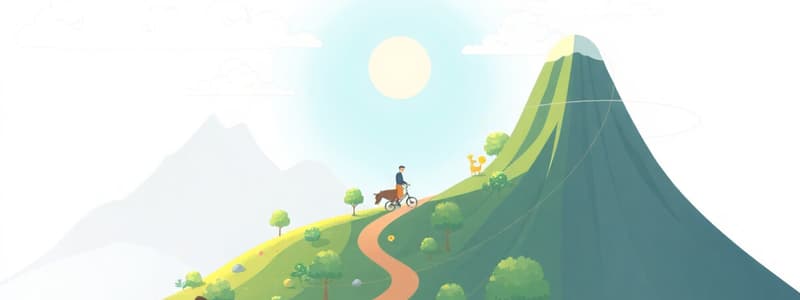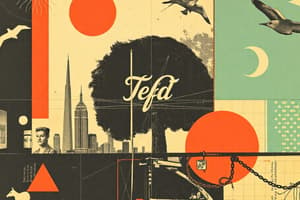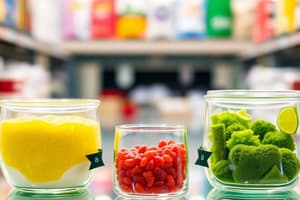Podcast
Questions and Answers
What describes the individuals who never buy a product innovation?
What describes the individuals who never buy a product innovation?
- Market innovators
- Brand loyalists
- Early adopters
- Non-adopters (correct)
What are the stages of the product life cycle (PLC)?
What are the stages of the product life cycle (PLC)?
- Development, introduction, growth, maturity, decline (correct)
- Creation, promotion, retention, termination
- Introduction, competition, market saturation, decline
- Concept, testing, launch, market sharing
What is brand equity?
What is brand equity?
- The popularity of a brand in the market
- The cost of creating a brand
- The customer loyalty associated with a brand
- The financial value of a brand (correct)
What occurs during the process of branding?
What occurs during the process of branding?
What is brand extension?
What is brand extension?
What is the primary reason customers purchase products?
What is the primary reason customers purchase products?
Which type of brand extension involves diversifying into unrelated product categories?
Which type of brand extension involves diversifying into unrelated product categories?
What do marketers need to consider at the planning stage of new product development?
What do marketers need to consider at the planning stage of new product development?
Which of the following is NOT a characteristic used to distinguish services from goods?
Which of the following is NOT a characteristic used to distinguish services from goods?
What is the definition of continuous innovation in marketing?
What is the definition of continuous innovation in marketing?
What do sensory benefits primarily appeal to?
What do sensory benefits primarily appeal to?
What aspect of branding includes visual designs and logos?
What aspect of branding includes visual designs and logos?
What is typically a result of premature product release in the market?
What is typically a result of premature product release in the market?
Which factor is NOT associated with the goods-services continuum?
Which factor is NOT associated with the goods-services continuum?
What is the core product level in the context of product offerings?
What is the core product level in the context of product offerings?
Which stage of new product development involves testing market demand and refining sales forecasts?
Which stage of new product development involves testing market demand and refining sales forecasts?
What do out-of-category extensions do in branding?
What do out-of-category extensions do in branding?
Which benefit addresses how customers emotionally respond to their purchases?
Which benefit addresses how customers emotionally respond to their purchases?
What is a co-brand in marketing?
What is a co-brand in marketing?
What are the essential motivating benefits that the customer is purchasing called?
What are the essential motivating benefits that the customer is purchasing called?
Which type of benefit relates to the emotional response elicited from a product purchase?
Which type of benefit relates to the emotional response elicited from a product purchase?
In which stage of the product life cycle do category sales begin to peak and then level off?
In which stage of the product life cycle do category sales begin to peak and then level off?
What type of innovation involves significant improvements to a product's delivery capabilities?
What type of innovation involves significant improvements to a product's delivery capabilities?
Which of the following is known for experiencing varying quality from provider to provider?
Which of the following is known for experiencing varying quality from provider to provider?
What does the term 'market nicher' refer to?
What does the term 'market nicher' refer to?
What is the primary focus during the planning step of product development?
What is the primary focus during the planning step of product development?
In terms of adopting innovations, who are the 'laggards'?
In terms of adopting innovations, who are the 'laggards'?
Which characteristic of services makes them impossible to store or keep for later?
Which characteristic of services makes them impossible to store or keep for later?
What does 'augmented product' refer to?
What does 'augmented product' refer to?
What stage comes immediately after the introduction stage in the product life cycle?
What stage comes immediately after the introduction stage in the product life cycle?
What is defined as the financial value of a brand?
What is defined as the financial value of a brand?
Which consumer group adopts innovation after the early adopters?
Which consumer group adopts innovation after the early adopters?
Which of the following best describes the 'product life cycle'?
Which of the following best describes the 'product life cycle'?
What is the main purpose of the commercialization stage in product development?
What is the main purpose of the commercialization stage in product development?
What is the primary function of brands for consumers?
What is the primary function of brands for consumers?
Which type of brand seeks to dominate a small segment of the market?
Which type of brand seeks to dominate a small segment of the market?
What best describes brand equity?
What best describes brand equity?
Why do brands help convey relative value?
Why do brands help convey relative value?
What is an example of an out-of-category brand extension?
What is an example of an out-of-category brand extension?
Which approach focuses on leadership in branding?
Which approach focuses on leadership in branding?
What is a characteristic of market challengers?
What is a characteristic of market challengers?
What is known as a co-brand strategy?
What is known as a co-brand strategy?
What is one reason new products fail at a high rate?
What is one reason new products fail at a high rate?
How are new products categorized in terms of innovation?
How are new products categorized in terms of innovation?
What are innovators in the diffusion of innovation framework?
What are innovators in the diffusion of innovation framework?
What does a brand's promise typically convey?
What does a brand's promise typically convey?
What is considered a low-price branding strategy focused on?
What is considered a low-price branding strategy focused on?
What signifies a brand concept being successfully commercialized?
What signifies a brand concept being successfully commercialized?
Flashcards
What are products?
What are products?
Products are what companies offer to customers in exchange for something of value, like money. Think of it as the tangible or intangible items you buy.
What are benefits?
What are benefits?
Benefits are the good things you get from using a product. They are the positive outcomes and advantages.
Sensory benefits
Sensory benefits
Sensory benefits appeal to your senses - sight, smell, taste, touch, and sound. They make products enjoyable or appealing.
Functional benefits
Functional benefits
Signup and view all the flashcards
Resource benefits
Resource benefits
Signup and view all the flashcards
Psychological benefits
Psychological benefits
Signup and view all the flashcards
Core product
Core product
Signup and view all the flashcards
Actual product
Actual product
Signup and view all the flashcards
Augmented product
Augmented product
Signup and view all the flashcards
What are services?
What are services?
Signup and view all the flashcards
Intangibility
Intangibility
Signup and view all the flashcards
Perishability
Perishability
Signup and view all the flashcards
Inseparability
Inseparability
Signup and view all the flashcards
Variability
Variability
Signup and view all the flashcards
What is innovation?
What is innovation?
Signup and view all the flashcards
Non-Adopters
Non-Adopters
Signup and view all the flashcards
Product Life Cycle (PLC)
Product Life Cycle (PLC)
Signup and view all the flashcards
PLC Stages
PLC Stages
Signup and view all the flashcards
Brand Equity
Brand Equity
Signup and view all the flashcards
Brand Extension
Brand Extension
Signup and view all the flashcards
What do customers buy?
What do customers buy?
Signup and view all the flashcards
Product as a bundle
Product as a bundle
Signup and view all the flashcards
Core Values
Core Values
Signup and view all the flashcards
Levels of a Product
Levels of a Product
Signup and view all the flashcards
Discontinuous Innovation
Discontinuous Innovation
Signup and view all the flashcards
Continuous Innovation
Continuous Innovation
Signup and view all the flashcards
Brand Name
Brand Name
Signup and view all the flashcards
Market Leader
Market Leader
Signup and view all the flashcards
Market Challenger
Market Challenger
Signup and view all the flashcards
Market Follower
Market Follower
Signup and view all the flashcards
Market Nicher
Market Nicher
Signup and view all the flashcards
Co-Branding
Co-Branding
Signup and view all the flashcards
Study Notes
8.1 What Products Mean to Marketers
- Products are benefit delivery systems; customers buy benefits, not products.
- Benefits include sensory, functional, resource, and psychological aspects.
- Products are total market offerings with multiple levels: core, actual, and augmented.
- Goods and services exist on a continuum; services are intangible, perishable, inseparable, and variable.
8.2 New Products and Innovation
- Innovation improves a product's benefit delivery, categorized as discontinuous (major improvement) or continuous (small improvement).
- New product development is a process involving conceptualization (idea generation, screening), planning (strategy development), and commercialization (production, launch).
- New product failures are common and costly, often due to issues like poor timing, inadequate marketing, and bad ideas.
8.3 Product Life Cycle
- The product life cycle (PLC) tracks sales and profits for a product category over time.
- Stages include development, introduction, growth, maturity, and decline.
- PLC patterns can be varied, including fads and fashions.
8.4 Product Brands and Branding
- Brands identify products and services, consisting of brand names (spoken) and brand marks (visual).
- Brand equity is the financial value of a brand, reflecting customers' willingness to pay more.
- Different brand roles exist (market leader, challenger, follower, nicher).
- Brand extensions (in-category, near-category, out-of-category) leverage existing brand equity.
- Co-branding combines two brands to create a new product.
- Branding develops a brand image, a collection of associations.
Studying That Suits You
Use AI to generate personalized quizzes and flashcards to suit your learning preferences.
Description
Test your knowledge on key marketing concepts including product innovation, stages of the product life cycle, brand equity, and branding processes. This quiz will help you understand the fundamentals essential for marketing strategies.




